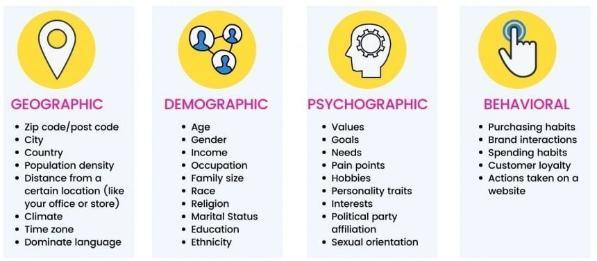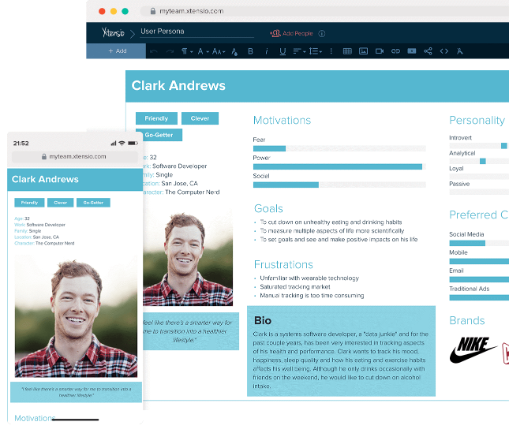Persona: what is it, how to define it and why create one?
Creating a persona is one of the essential steps in a Digital Marketing strategy. Understanding the target audience is critical for producing content that will guide the acquisition of new customers.
What is a persona?
In a briefing definition, a persona is the fictional representation of an ideal customer, and it is based on real data about customers’ behaviour and demographic characteristics (Vaughan, 2022).
The persona can be identified precisely through contact with your target audience. Besides, if you have a customer base, this will be the perfect source to start your investigations. Even if you have different profiles of people or companies that consumed your product or service, some of them tend to exemplify your persona. An important tip is to focus on both satisfied and dissatisfied customers. In either case, you will surely learn something about the perception of your product or service and what challenges your customers are facing.
What is the difference between persona and target audience? It is common to be confused with these concepts. So, let us make one thing very clear: persona and target audience are not synonymous! See a practical example:
Target audience: Men and women, 24 to 30 years old, single, graduated in architecture, with an average monthly income of £3,500. They intend to increase their professional qualification and enjoy travelling.
Persona: Arthur is 26 years old, from Massachusetts. He is a recently graduated and self-employed architect. He thinks of developing professionally through a master’s degree abroad, as he loves to travel, is single, and is looking for an agency to help him find universities in Europe that accept international students.
Generally speaking, the target audience is a broad part of society to sell your products or services. On the other hand, the persona represents your ideal customer more humanised and personalised.
Why create a persona? Creating personas is a fundamental step within a Digital Marketing strategy for great results. We develop personas to send the right message to the right people and, thus, have greater chances of success! Without a defined persona, your strategy may get lost in some cases, and you can end up talking to the wrong audience.
How to create a persona? Fletcher et al. (2020, p.72) suggest identifying them by geographical, demographic, psychological and behavioural segmentation. E.g., Age, title, habits, frustrations, challenges, beliefs, hobbies, lifestyle, shopping habits, which social media they prefer, etc.

(Flashman, 2021)
Creating names for the personas is also vital because it facilitates internal debates, targeting the persona. For example: “Do you believe that Isabelle would be interested in that?”
Another possibility is to use some graphic model to represent the persona:

(Xtensio, no date)
Therefore, defining a persona for your company is essential to direct digital marketing strategies. By profiling an ideal customer, the task of developing marketing and content pieces aimed at someone who summarises your audience becomes much easier, and your strategy will surely be successful.
-ends-
By Bruna Menegon Ianicelli. Bruna is a final year student of BA Marketing Management.
References:
Flashman, J. (2021) How To Set Up Market Segmentation And Make More Money. ReferralCandy. Available at: https://www.referralcandy.com/blog/what-is-market-segmentation (Accessed 16 Feb 2022).
Fletcher, G., Cruz, A., Heinze, A. and Rashid, T. (2020) Digital and social media marketing: a results-driven approach. 2nd ed. Milton Park: New York: Routledge, p.72.
Vaughan, P. (2022) How to Create Detailed Buyer Personas for Your Business [Free Persona Template]. Hubspot. Available at: https://blog.hubspot.com/marketing/buyer-persona-research (Accessed 18 Feb 2022).
Xtensio (no date) How To Create A User Persona. Available at: https://xtensio.com/how-to-create-a-persona/ (Accessed 16 Feb 2022).


/prod01/wlvacuk/media/departments/digital-content-and-communications/images-18-19/iStock-163641275.jpg)
/prod01/wlvacuk/media/departments/digital-content-and-communications/images-2024/250630-SciFest-1-group-photo-resized-800x450.png)
/prod01/wlvacuk/media/departments/digital-content-and-communications/images-18-19/210818-Iza-and-Mattia-Resized.jpg)
/prod01/wlvacuk/media/departments/digital-content-and-communications/images/Maria-Serria-(teaser-image).jpg)
/prod01/wlvacuk/media/departments/digital-content-and-communications/images-2024/241014-Cyber4ME-Project-Resized.jpg)
/prod01/wlvacuk/media/departments/digital-content-and-communications/images-18-19/210705-bric_LAND_ATTIC_v2_resized.jpg)